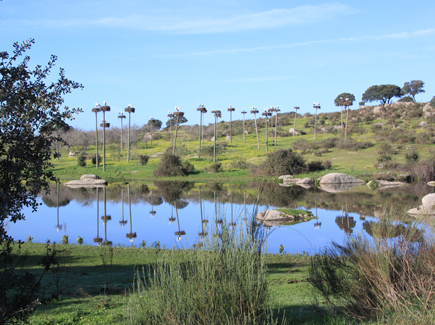In the European Stork Village Malpartida de Caceres in Spain, the white stork breeding season has begun. Last year, for the first time, as many storks bred there as in 2009. This success is thanks to the wetland created by the local municipality supported by EuroNatur to improve conditions for nesting and feeding for the storks.

The artificial nests within the new wetland have been well received by the storks.
© Gemeinde Malpartida de CáceresFor many years beforehand, the storks had been going to the nearby waste site in search of food. When the rubbish dump closed in 2009, the number of white stork fell as a consequence. “Waste sites offer the white stork an easily accessible source of food, providing them with good feeding conditions for raising their young,” explains EuroNatur bird expert Stefan Ferger.
The local municipality had already begun to create ponds and introduce water into meadows back in 2006 in order to provide these spindly long-legged creatures with an alternative source of food. Frogs, tadpoles and other inhabitants of aquatic habitats are right at the top of the stork’s daily menu. From 2014, the wetland has been extended bit by bit as part of the “Wetland meadows and pasture” project supported by, amongst others, the Pancivis foundation and the Aage V. Jensen foundation. Their efforts have been met with success: in 2015 a total of 156 stork pairs bred in Malpartida de Caceres – of which 24 were on the 1.4 hectare wetland.
“This shows that we’re on the right road with the measures we’ve taken. Now we hope that there will be plenty of young storks to delight us again this year,” says Stefan Ferger.
Read more about EuroNatur's work to protect the white stork
To the "European Stork Villages" programme and the villages designated so far


